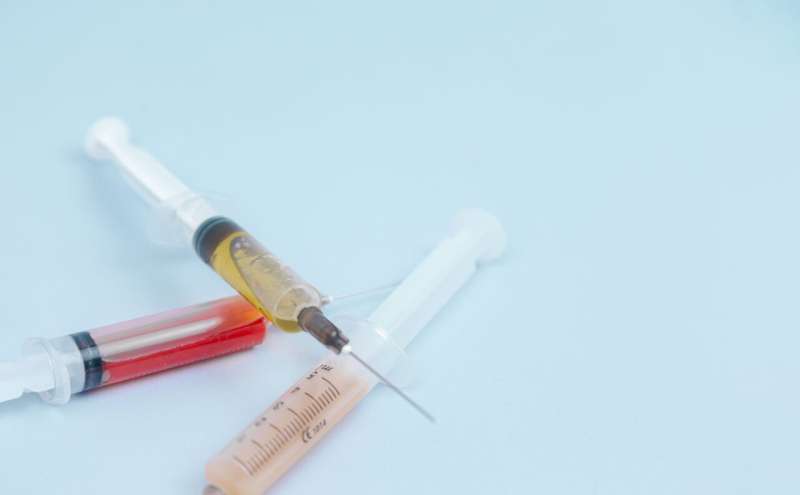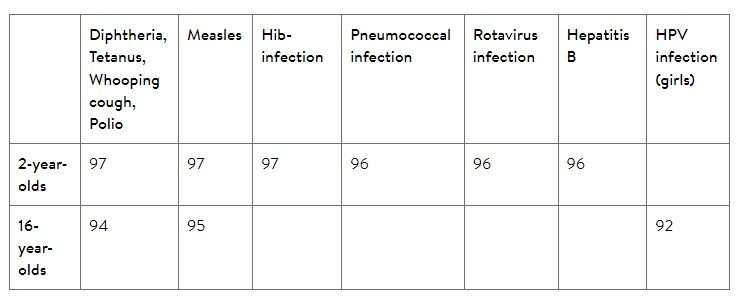
Despite the demands of the coronavirus pandemic on resources, the 2021 coverage statistics from the Norwegian Immunization Registry SYSVAK show a consistently high vaccine uptake for children and adolescents. The Norwegian population continues to be well-protected against these infectious diseases.
The vaccination coverage for three cohorts (for 2-, 9- and 16-year-olds) is published annually. The 2021 coverage statistics show that the vast majority of children and adolescents were able to follow their immunization schedule during the coronavirus pandemic.
Impressive effort
Public health nurses have a key role in the health of children and adolescents, with vaccination being just one of many responsibilities. For several decades, there has been consistently high vaccine uptake in the Norwegian childhood immunization program, and this is still the case.
“This year’s coverage figures show that the healthcare service has made an impressive effort to offer vaccines to children and adolescents despite a demanding pandemic period. This demonstrates that the childhood immunization program is robust, and has been prioritized,” says Margrethe Greve-Isdahl, Senior Physician at the Norwegian Institute of Public Health.
Protects against transmission
The extremely low incidence of the diseases that are vaccinated against in Norway reflects the high uptake in the childhood immunization program in Norway. Other countries have greater challenges in implementing their childhood immunization programs.
This can lead to some diseases flaring up in countries with lower vaccination coverage.
“The high vaccination coverage in Norway makes it unlikely that these diseases will spread here, even if sporadic cases are detected,” Greve-Isdahl adds.
70th anniversary
The Norwegian childhood immunization program was established in 1952 with a combination vaccine against diphtheria, tetanus and pertussis (whooping cough). Since then, more vaccines have been introduced, with vaccines against 13 diseases now being offered.
The Norwegian Institute of Public Health monitors and publishes coverage statistics for the childhood immunization program annually, and these data are included in the Norgeshelsa statistics database from 2002. Vaccination coverage for diphtheria, tetanus and pertussis has been consistently high over the years.
“This success can be attributed, among other things, to the organization of the childhood immunization program. The vaccines are free and easily available and are a well-established and integral part in the follow-up of children’s health. Several studies show that the population has a high level of trust in the health service and the vaccines that are offered,” says Greve-Isdahl.
HPV vaccination
The human papillomavirus (HPV) vaccine was introduced for girls in the childhood immunization program in 2009. In 2021, the coverage is up to 92 percent for girls, which is among the highest in the world. Boys have been offered HPV vaccine since 2018 and will be included in the coverage statistics for 16-year-olds from next year.
“The Norwegian Institute of Public Health has conducted a study that shows that Norway could possibly eradicate cervical cancer in 2039, thanks to the high uptake of the HPV vaccine,” says Lill Trogstad, head of the Norwegian HPV vaccine program.
Excerpts from the national coverage figures for 2021
The table below shows an excerpt of the national vaccination coverage for 2021 for 2-year-olds and 16-year-olds.

Facts about the coverage statistics
- All vaccines given in the childhood immunization program must be notified to the Norwegian immunization registry SYSVAK by public health clinics and the school health service on an individual level. The vaccination coverage statistics show the proportion of children who have been vaccinated according to the recommendations in the immunization program.
- The annual vaccination coverage published is a minimum figure, and the actual coverage may be higher than the statistics indicate. The most common reason why some children appear to be incompletely vaccinated is due to technical problems with the electronic transmission of vaccine notifications from the municipalities to SYSVAK.
- Vaccination coverage is published at national and county level for three age groups: 2, 9 and 16-year-olds. The municipal statistics are published in the municipal health statistics database—Kommunehelsa statistikkbank (in Norwegian).
Source: Read Full Article
